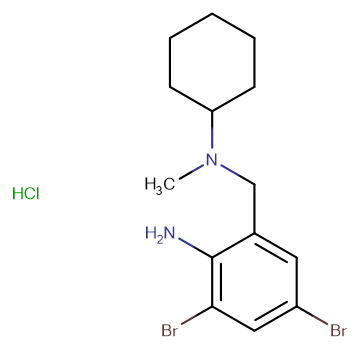
Bromhexine hydrochloride
CAS No. 611-75-6
Bromhexine hydrochloride( —— )
Catalog No. M15301 CAS No. 611-75-6
Bromhexine Hydrochloride is a medication prescribed for coughs which works by dissolving hard phlegm.
Purity : >98% (HPLC)
 COA
COA
 Datasheet
Datasheet
 HNMR
HNMR
 HPLC
HPLC
 MSDS
MSDS
 Handing Instructions
Handing Instructions
| Size | Price / USD | Stock | Quantity |
| 200MG | 27 | In Stock |


|
| 500MG | 41 | In Stock |


|
| 1G | Get Quote | In Stock |


|
Biological Information
-
Product NameBromhexine hydrochloride
-
NoteResearch use only, not for human use.
-
Brief DescriptionBromhexine Hydrochloride is a medication prescribed for coughs which works by dissolving hard phlegm.
-
DescriptionBromhexine Hydrochloride is a medication prescribed for coughs which works by dissolving hard phlegm.(In Vitro):Bromhexine hydrochloride (BHH; 250μM; 24 hours) also significantly attenuates HGF-induced invasion of LNCaP and C4-2B cells that natively express TMPRSS2.No significant toxicity is observed over a 48-hour period exposing LNCaP, DU145, PC3, or HepG2 cells to Bromhexine hydrochloride concentrations ranging from 0μM to 250μM. Bromhexine hydrochloride exposure does not induce cell death or substantially suppress the growth of DU145 cells.Bromhexine hydrochloride (20?μM; 48?h) inhibits dendritic cells infection with HIV-1.(In Vivo):Bromhexine hydrochloride (30mg/kg; ip; three times per week for 5 weeks) significantly reduces the incidence of distant metastasis to lung and liver sites from 55% in vehicle-treated animals to 20% in Wild-type C57BL/6 and TRAMP mice with PIN (prostatic intraepithelial neoplasia). The prostate glands of the mice treated with Bromhexine hydrochloride are generally substantially larger than vehicle-treated TRAMP mice.
-
In VitroBromhexine hydrochloride (BHH; 250μM; 24 hours) also significantly attenuates HGF-induced invasion of LNCaP and C4-2B cells that natively express TMPRSS2.No significant toxicity is observed over a 48-hour period exposing LNCaP, DU145, PC3, or HepG2 cells to Bromhexine hydrochloride concentrations ranging from 0μM to 250μM. Bromhexine hydrochloride exposure does not induce cell death or substantially suppress the growth of DU145 cells. Bromhexine hydrochloride (20?μM; 48?h) inhibits dendritic cells infection with HIV-1.
-
In VivoBromhexine hydrochloride (30mg/kg; ip; three times per week for 5 weeks) significantly reduces the incidence of distant metastasis to lung and liver sites from 55% in vehicle-treated animals to 20% in Wild-type C57BL/6 and TRAMP mice with PIN (prostatic intraepithelial neoplasia). The prostate glands of the mice treated with Bromhexine hydrochloride are generally substantially larger than vehicle-treated TRAMP mice.
-
Synonyms——
-
PathwayOthers
-
TargetOther Targets
-
RecptorOthers
-
Research AreaMetabolic Disease
-
Indication——
Chemical Information
-
CAS Number611-75-6
-
Formula Weight412.59
-
Molecular FormulaC14H21Br2ClN2
-
Purity>98% (HPLC)
-
SolubilityEthanol: 5 mg/mL (12.11 mM); DMSO: 6 mg/mL (14.54 mM)
-
SMILESCl.CN(CC1=CC(Br)=CC(Br)=C1N)C1CCCCC1
-
Chemical Name——
Shipping & Storage Information
-
Storage(-20℃)
-
ShippingWith Ice Pack
-
Stability≥ 2 years
Reference
1.Prescrire Int. 2015 Apr;24(159):98.
molnova catalog



related products
-
Bid BH3
Bid BH3
-
Butyl benzyl phthala...
It is mostly used as a plasticizer for PVC. It is considered a toxicant.
-
DZ2002
DZ2002, an orally active, reversible, and low-cytotoxic type III SAHH inhibitor (Ki=17.9 nM), exhibits significant immunosuppressive activity.



 Cart
Cart
 sales@molnova.com
sales@molnova.com


